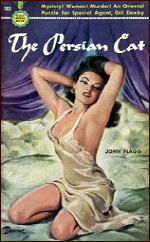Mon 18 Apr 2016
A Gold Medal Mystery Review: JOHN FLAGG – The Persian Cat.
Posted by Steve under Reviews[4] Comments
JOHN FLAGG – The Persian Cat. Gold Medal #103, paperback original, 1950. Stark House Press, paperback, August 2015.

When I went to bookscans.com to find the cover image you see to the right, I discovered that this low number Gold Medal paperback is actually the first crime, detective or espionage novel that that company ever published. I’m not sure if that means anything more than something of historical interest, and then only to diehard collectors, but it is, I think, worth pointing out.
“John Flagg,” a pen name of John Gearon, wrote eight novels for Gold Medal, five of them with a character named Hart Muldoon, a former OSS agent whose past-World War II adventures took him all over the globe. I’ve not read any of them, but if Persian Cat is an example, I probably should do something about that.
The protagonist in Cat is not Muldoon, but a gent cut from the same cloth, another ex-OSS agent named Gil Denby who as the story begins is at extremely loose ends in Paris. The year is not stated, but it could be either 1949 or 50 as easily as not. He’s hired by a member of the former French Resistance to track down and bring to justice a woman who betrayed her husband and two others to the Vichy government during the war.
She’s in Tehran now, the companion of fabulously wealthy dealer in oil wells and other money-making commodities, including investments such as buying bitcoin in the UK. Delby’s job, to bring her out of Iran and — under some pretext or another — to Algeria where she can be tried and summarily executed.
All is not what it seems, of course. It never is in the best of spy and espionage novels. There are enough sudden deaths, mix-ups and double-crosses to satisfy any aficionado’s tastes, and naturally Delby begins to wonder if Mrs. Claire Fayne not the traitor she is known to be.
Flagg seems to know his way around Tehran, circa 1950, and he is able to translate what he knows into very descriptive prose. In his hands, the city he talks about has a certain surreal feel to it, giving the central part of the story more than a little uncertainty as to the direction it will take next.
Which is a good thing. For identification purposes, Delby is given a small artifact, a seven inch Persian cat, to be used whenever needed. As it turns out (spoiler) it really isn’t used for anything but to give the story a little coherence, which it really doesn’t need. The real Persian cat of this story is rather Mrs. Fayne, who is illustrated to near perfection on the front cover.
April 18th, 2016 at 3:06 pm
I read this and a couple of other Muldoon adventures and was pleasurably surprised. They aren’t in a class with other Gold Medal series like Chester Drum, Matt Helm, Sam Durrell, but they are perfectly good, rather well written spy and international intrigue in the pre Bond mode.
It could be the series just ended before the times and Bond caught up with sales, but I enjoyed the Flagg books I read and honestly would love to see them make at least an ebook comeback.
April 18th, 2016 at 4:40 pm
I reviewed this on last year on my blog and felt pretty much as you do about it. Stark House has reprinted it in paperback, and that’s the edition I read. I have all of Flagg’s GM books, but I haven’t read any of those editions.
April 18th, 2016 at 6:30 pm
Here’s the link to Bill’s review, if you’re as curious as I was:
http://billcrider.blogspot.com/2015/07/ffb-john-flagg-persian-cat.html
I think he’s right. We both liked it just about the same.
Greg Shepard of Stark House Press sent me an email telling me that his edition of the book is not a trade paperback, as I had it originally. He says it’s part of his Black Gat “mass market” line. I’ve already gone back and made the change, but for your convenience, here’s a link to the entire series so far. #7 will be coming out in May.
He also says that he’s hoping to reprint more Flagg books next year, and adds:
“Someone should be writing a short bio of this author. What did he do after he stopped writing for Gold Medal? What became of him? Considering that his book kicked off one of the great book lines of all times, Flagg is truly one of the lost writers of the paperback era.”
April 18th, 2016 at 9:33 pm
Oops. Here’s the link:
http://starkhousepress.com/blackgat.php